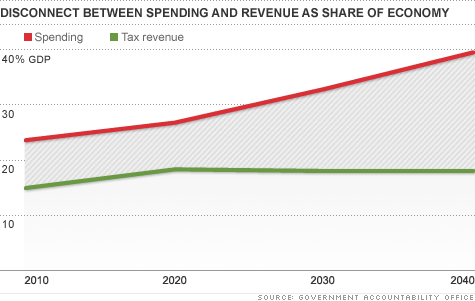
NEW YORK (CNNMoney) -- The United States has a spending problem, not a revenue problem.
That is the persistent Republican mantra whenever the question of how to reduce deficits comes up. The party line: Cut spending, and under no circumstances raise taxes.
The GOP is right about one thing: The country is spending more than it can afford. And economists on the left and right generally agree that big tax increases can hurt economic growth. (Fix budget before a crisis)
But there is abundant evidence showing that taxes must be part of debt reduction, however distasteful the GOP finds them.
Why? Because the looming debt problem is just too big. And reducing it by spending cuts alone would require draconian changes that could hurt the economy far more than a mix of spending cuts and tax increases.
Here's one way to conceive of just how big the problem is.
If lawmakers wanted to permanently freeze the debt held by the public at the today's level -- 62% of GDP -- they would need to immediately cut spending by 35% or about $1.2 trillion, according to the Government Accountability Office. And those cuts would need to be permanent from hereon out.
How hard would that be?
Consider that in 2010, all of discretionary spending -- including defense -- totaled $1.35 trillion. In other words, to do deficit reduction all on the spending side means "you have to cut into the real meat," said Roberton Williams, senior fellow at the Tax Policy Center.
Consider, too, how much fun lawmakers are having right now trying to negotiate spending cuts for this year alone. Their working range: Between $10 billion and $61 billion.
And here's the kicker: Even permanently cutting $1.2 trillion today wouldn't be the end of the story. Deficit hawks note that public debt at 60% is still well above the country's historical average -- which is below 40%. So more cutting would need to occur in subsequent decades.
One the biggest reasons for increased spending -- and hence, high debt -- is the aging of the population. That means burgeoning Medicare and Social Security rolls, especially over the next 25 years.
Inflation in health care costs is the other big problem.
In both cases, fixing those problems without increasing revenue isn't feasible. For one, kicking grandma to the curb is not really an option in civilized society. And making adjustments to spending will not happen overnight.
Done right, benefit changes would have to be phased in so future retirees can adjust their plans accordingly. And reducing health care costs requires systemic changes over time.
"Since retirement program reforms can only be made slowly, we must also cap defense and non-defense discretionary spending, restrain other mandatory programs, and restructure the tax code to raise more revenue," said federal budget expert Alice Rivlin at a Senate Budget Committee hearing last week.
If that doesn't happen and lawmakers instead keep tax revenue at around 18% of GDP -- the historical average -- "by 2040 we will only be collecting enough revenue to cover the costs of net interest and not quite all of Social Security," budget expert Diane Rogers noted in her blog Economistmom.com.
The fastest growing area of spending is interest on the debt, which is expected to approach $1 trillion a year by the end of this decade.
Since tax cuts don't pay for themselves, they reduce revenue going into federal coffers. And that increases the debt. More debt means higher interest costs.
While Republicans portray President Obama as the biggest of big spenders, in fact the driving force behind the big deficits in his 2012 budget proposal isn't spending. It's his proposed tax cuts, and the increased interest costs that result, according to an analysis by the independent Congressional Budget Office.
The $1 trillion in annual tax breaks also exacerbate the spending problem and have the perverse effect of pushing some rates higher.
The president's bipartisan debt commission called this phenomenon out.
"Instead of promoting economic growth and competitiveness, our current code drives up health care costs and provides special treatment to special interests. The code presents individuals and businesses with perverse economic incentives instead of a level playing field," the commission wrote in its final report.
In the current debate, some Republicans are reluctantly acknowledging that taxes might need to play a role in debt reduction.
"Taxes? They'll be a bitter pill for me. But we have got to get this country on the right path. ... I'd have to challenge [calls to put taxes on the table], but I would look at it," Jeff Sessions, the top Republican on the Senate budget committee, told Bloomberg's Al Hunt earlier this month.
Meanwhile, three other Republican senators -- Tom Coburn, Mike Crapo and Saxby Chambliss -- are part of the bipartisan Gang of Six, which is looking to turn the proposals from President Obama's debt-reduction commission into legislation.
A key commission recommendation: Reform the tax code by eliminating most tax breaks. That would raise a lot of revenue, and the commission proposal would use most of it to reduce rates. But it would also earmark a small amount for deficit reduction. ![]()
| Latest Report | Next Update |
|---|---|
| Home prices | Aug 28 |
| Consumer confidence | Aug 28 |
| GDP | Aug 29 |
| Manufacturing (ISM) | Sept 4 |
| Jobs | Sept 7 |
| Inflation (CPI) | Sept 14 |
| Retail sales | Sept 14 |